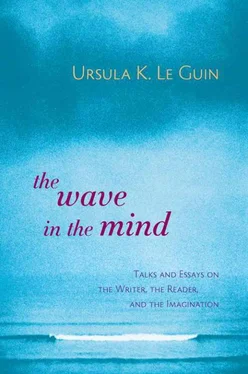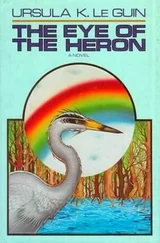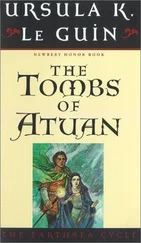Spinning the fleece of the sun, that cloudy mass,
weaving a glance and a gesture,
shaping the clay of emotion:
housekeeping. Patterning.
Following patterns.
Lying there
in the dreamtime
following patterns.
So then you have to cut it out—
take a deep breath,
the first cut, the blank page!—
and sew it together (drudgery,
toil in the sacred sweatshop),
the garment, the soul-coat,
the thing made of words,
cloth of the sunfleece,
the new clothes of the Emperor.
(Yes, and some kid comes along
and yaps, “But he hasn’t any clothes on!”
Muzzle the brat
till it learns
that none of us has any clothes on,
that our souls are naked,
dressed in words only,
in charity only,
the gift of the others.
Any fool can see through it.
Only fools say so.)
Long ago when I was Ursula
writing, but not “the writer,”
and not very plural yet,
and worked with the owls not the sparrows,
being young, scribbling at midnight:
I came to a place
I couldn’t see well in the darkness,
where the road turned
and divided, it seemed like,
going different ways.
I was lost.
I didn’t know which way.
It looked like one roadsign said To Town
and the other didn’t say anything.
So I took the way that didn’t say.
I followed
myself.
“I don’t care,” I said,
terrified.
“I don’t care if nobody ever reads it!
I’m going this way.”
And I found myself
in the dark forest, in silence.
You maybe have to find yourself,
yourselves,
in the dark forest.
Anyhow, I did then. And still now,
always. At the bad time.
When you find the hidden catch
in the secret drawer
behind the false panel
inside the concealed compartment
in the desk in the attic
of the house in the dark forest,
and press the spring firmly,
a door flies open to reveal
a bundle of old letters,
and in one of them
is a map
of the forest
that you drew yourself
before you ever went there.
The Writer At Her Work:
I see her walking
on a path through a pathless forest,
or a maze, a labyrinth.
As she walks she spins,
and the fine thread falls behind her
following her way,
telling
where she is going,
where she has gone.
Telling the story.
The line, the thread of voice,
the sentences saying the way.
The Writer On Her Work:
I see her, too, I see her
lying on it.
Lying, in the morning early,
rather uncomfortable.
Trying to convince herself
that it’s a bed of roses,
a bed of laurels,
or an innerspring mattress,
or anyhow a futon.
But she keeps twitching.
There’s a lump , she says.
There’s something
like a rock —like a lentil—
I can’t sleep.
There’s something
the size of a split pea
that I haven’t written.
That I haven’t written right.
I can’t sleep.
She gets up
and writes it.
Her work
is never done.
“Introducing Myself,” copyright © 1992 by Ursula K. Le Guin, first appeared in Left Bank .
“My Island,” copyright © 1996 by Ursula K. Le Guin, first appeared in Islands: An International Magazine .
“On the Frontier,” copyright © 2003 by Ursula K. Le Guin; an earlier version of this essay entitled “Which Side Am I On, Anyway?” appeared in Frontiers , 1996.
“All Happy Families,” copyright © 1997 by Ursula K. Le Guin, first appeared in Michigan Quarterly Review , Winter 1997.
“Things Not Actually Present: On The Book of Fantasy and J. L. Borges,” copyright © 1988 by Ursula K. Le Guin, first appeared as the introduction to the Viking edition of The Book of Fantasy .
“Reading Young, Reading Old: Mark Twain’s Diaries of Adam and Eve ,” copyright © 1995 by Ursula K. Le Guin, first appeared as the introduction to The Diaries of Adam and Eve in The Oxford Mark Twain.
“Thinking about Cordwainer Smith,” copyright © 1994 by Ursula K. Le Guin, first appeared in the Readercon 6 program book.
“Rhythmic Pattern in The Lord of the Rings ,” copyright © 2001 by Ursula K. Le Guin, first appeared in Meditations on Middle Earth .
“The Wilderness Within: The Sleeping Beauty and ‘The Poacher,’” copyright © 2002 by Ursula K. Le Guin, first appeared in Mirror, Mirror on the Wall: Women Writers Explore their Favorite Fairy Tales , 2d ed.
“Off the Page: Loud Cows: A Talk and a Poem about Reading Aloud,” copyright © 1992 by Ursula K. Le Guin, first read at the National Council for Research on Women Awards and appears as the frontispiece of The Ethnography of Reading , ed. Jonathan Boyarin, 1994.
“Dogs, Cats, and Dancers: Thoughts about Beauty,” copyright © 1992 by Ursula K. Le Guin, first appeared in Allure .
“The Writer on, and at, Her Work,” copyright © 1991 by Ursula K. Le Guin, first appeared in The Writer on Her Work , vol. 2.
All other essays are copyright © 2003 by Ursula K. Le Guin and appear for the first time in this volume.
URSULA K. LE GUIN is the winner of the Hugo, Nebula, Gandalf, Kafka, and National Book Awards. She is the author of many short stories and more than fifteen novels, including The Left Hand of Darkness and The Dispossessed . She is also an honored author of children’s books, poetry, and criticism.
Sign up to learn more about our books and receive special offers from Shambhala Publications.
Sign Up
Or visit us online to sign up at shambhala.com/eshambhala.
Shambhala Publications, Inc.
Horticultural Hall
300 Massachusetts Avenue
Boston, Massachusetts 02115
www.shambhala.com
© 2004 by Ursula K. Le Guin
Cover photograph by John Brown/Getty Images
All rights reserved. No part of this book may be reproduced in any form or by any means, electronic or mechanical, including photocopying, recording, or by any information storage and retrieval system, without permission in writing from the publisher.
Library of Congress Cataloging-in-Publication Data
Le Guin, Ursula K., 1929–
The wave in the mind: talks and essays on the writer, the reader, and the imagination/Ursula K. Le Guin—1st ed.
p. cm
eISBN 978-0-8348-2563-5
ISBN 978-1-59030-006-0 (alk. paper)
1. Le Guin, Ursula K., 1929– 2. Le Guin, Ursula K., 1929—Authorship. 3. Science fiction—Authorship. 4. Science fiction—History and criticism. I. Title.
PS3562.E42 W38 2004
813′.54—DC21
200301931
I want to thank Dell Hymes for giving me the whole idea of reading prose this way—though of course he bears no responsibility for my extensions and misuses. His work with the written version of oral narrative is stunning in its revelation of complex, conscious, formal pattern in Native American narratives long considered “artless,” “primitive,” etc.
Читать дальше



